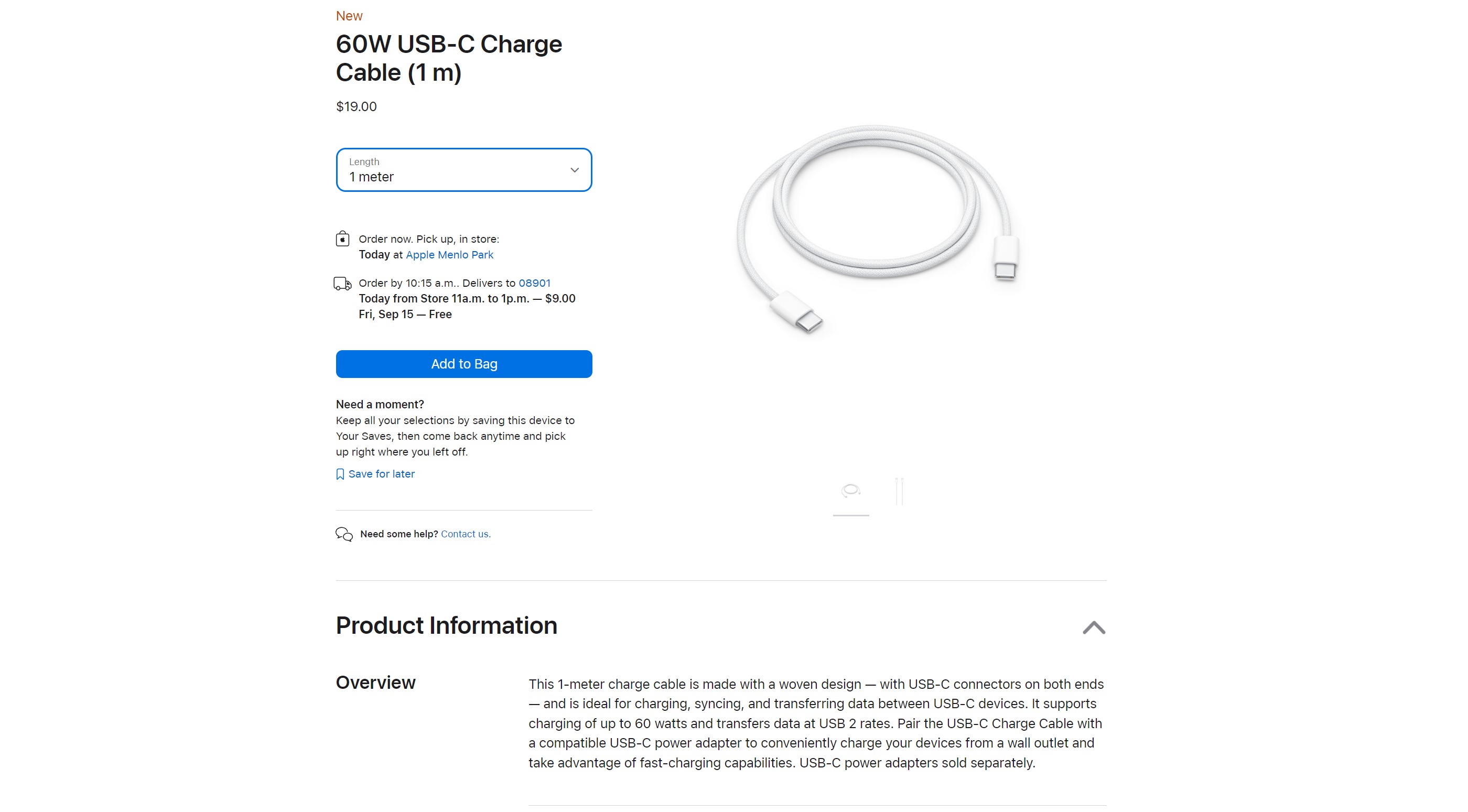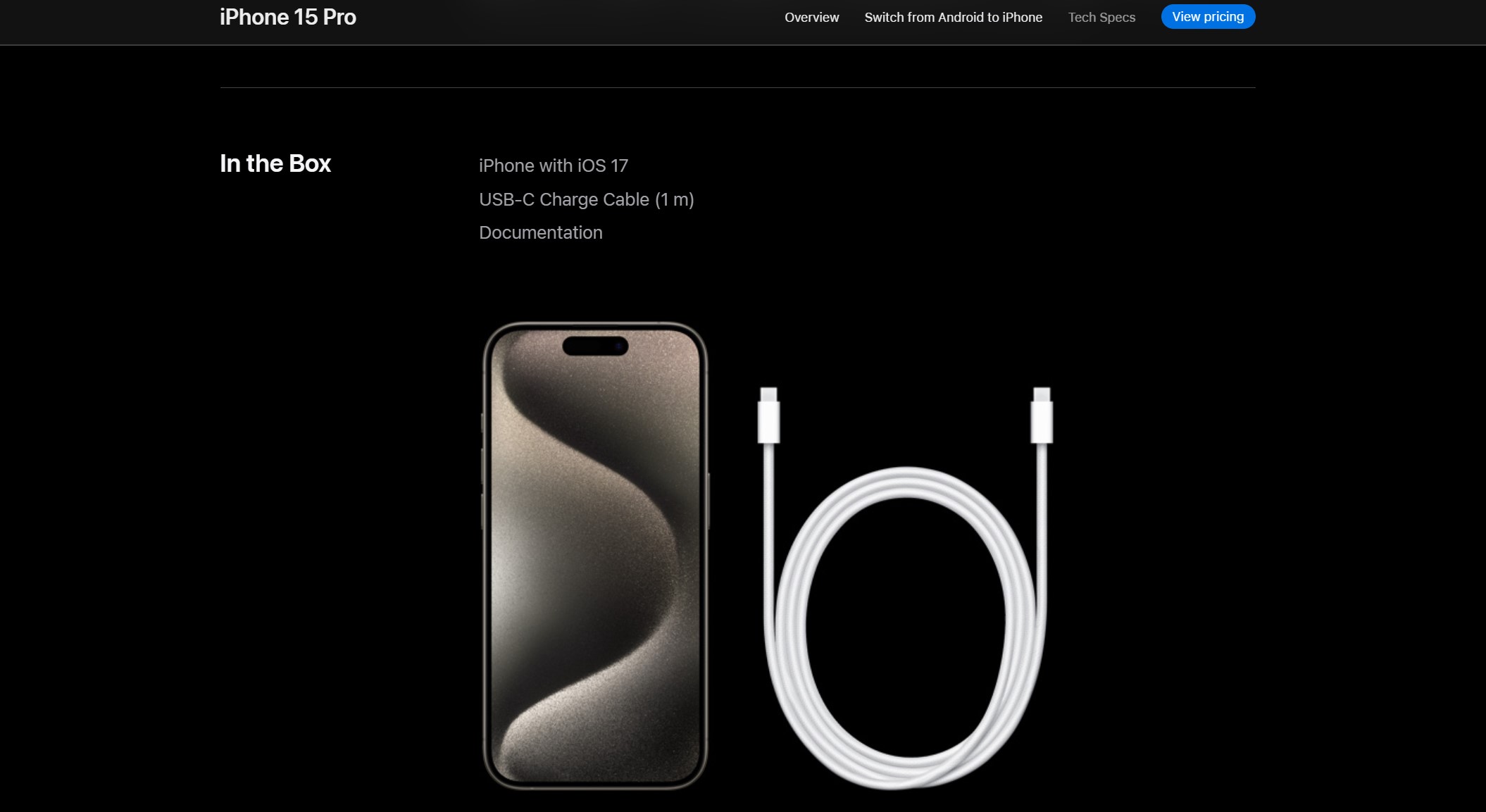This week Apple introduced the iPhone 15 and iPhone 15 Pro lines which include the long-awaited switch from the company’s proprietary Lightning Connector to USB-C. And while the move may have been motivated more by EU regulations than a desire to increase usability, having all the major smartphone makers finally using the same port for data and charging is a positive development. Unfortunately, Apple’s transition seems to be bringing some additional confusion to the standard.
Now for those of you familiar with the peculiarities of USB-C, a bit of extra complexity probably doesn’t come as a big surprise. That’s because the USB-C really only refers to the connector itself (as opposed to the traditional boxy USB-A plug or the smaller trapezoidal microUSB jack aka USB Micro-B), while other standards dictate things like data speeds, power delivery and more. The good news is that now that all the big OEMs are using the same port, hopefully the days of asking a friend to borrow an iPhone charging cable or an Android power cord will soon be a thing of the past.

The compare tool on Apple's website really highlights the difference in data transfer speeds between the iPhone 15 and the iPhone 15 Pro/Pro Max.
Apple
However, the way Apple is implementing USB-C on the new iPhone 15 and 15 Pro is making things trickier. The first issue is that data transfers on the iPhone 15 and 15 Plus are capped at USB 2.0 speeds (480 Mbps), which is the same as what you get with a Lightning Connector. Meanwhile, Apple lists the iPhone 15 Pro and Pro Max with support for “USB 3” data transfer of up to 10 Gbps, or around 20 times faster.
That’s a huge difference and I’m not sure why Apple limited the iPhone 15s to this degree – especially when you consider all the similarly priced Android phones like the Pixel 7 that feature data speeds of up to 10Gbps. To make matters worse, Apple’s use of “USB 3” to describe transfer rates on the iPhone 15 Pro and Pro max doesn’t seem quite right. USB 3.0 (which is not the same thing as USB 3) is supposed to top out at 5 Gbps, which suggests that Apple is actually using USB 3.1 Gen 2 or USB 3.2 Gen 2 on its new phones (both of which go up to 10Gbps) and just labeling it as USB 3 for the sake of simplicity. Confused yet? This is one reason why the USB-IF (the group that governs the USB spec) would prefer for companies to state the data speeds of their devices instead of citing a USB version number.

Apple
On a more practical level, trying to purchase the right cables or adapters for your device might present a challenge. Currently, if you go to Apple’s website, click on the Accessories tab, choose to browse by product (in this case iPhone) and select the section for Power & Cables, you won’t actually find any double-sided USB-C cords on that page. There is a listing for Apple’s new USB-C to Lightning Adapter, which feels a bit pricey at $29, but as for cables, you’re looking at a bunch of USB to Lightning cords which are about to be outdated.
In order to find a cable that you can actually use, you’ll need to head over to the iPad or Mac sections where you can choose between a one-meter double-side USB-C cable for $19 or a longer two-meter option for $29. But even with this cable, things are a bit weird. That’s because the one-meter cord delivers charging speeds at up to 60 watts while the two-meter cable can handle up to 240 watts. That’s plenty given that all versions of the iPhone 15 top out with 27-watt charging. But, both cables only support data transfers of up to “USB 2 rates” aka 480 Mbps. More annoyingly, Apple doesn't offer specs for the wire that comes with the iPhone 15 Pro and it very well might be the same one-meter USB-C Charge Cable that’s capped to USB 2 speeds. That’s not great for anyone buying an iPhone 15 Pro who is basically hamstringing their very expensive handset with a slow bundled cord.

Apple
Furthermore, in the iPhone accessories section, the cheapest first-party USB-C power adapter tops out at 20 watts, which doesn’t take full advantage of the latest iPhone’s charging speeds. That’s a bit of a problem, because like a lot of phones these days, the iPhone 15 doesn’t come with a bundled charging brick. So unless you already have an adapter from a MacBook or iPad Pro, you’ll need to shell out extra for that while trying to figure out the wattage you actually need. It’s also unclear if the iPhone 15 supports USB Power Delivery with PPS (programmable power supply) that allows a device and charger to dynamically adjust voltage to achieve peak speeds and efficiency.
Granted, it’s still early and the iPhone 15 line hasn’t even gone on sale yet, so I’m sure Apple will be rolling out more options to support its latest devices. But for Apple – a company that long prided itself on making devices that just work – the debut of USB-C on the iPhone seems kind of messy.
This article originally appeared on Engadget at https://www.engadget.com/apples-swi...s-more-cable-confusion-140030611.html?src=rss
Now for those of you familiar with the peculiarities of USB-C, a bit of extra complexity probably doesn’t come as a big surprise. That’s because the USB-C really only refers to the connector itself (as opposed to the traditional boxy USB-A plug or the smaller trapezoidal microUSB jack aka USB Micro-B), while other standards dictate things like data speeds, power delivery and more. The good news is that now that all the big OEMs are using the same port, hopefully the days of asking a friend to borrow an iPhone charging cable or an Android power cord will soon be a thing of the past.
The compare tool on Apple's website really highlights the difference in data transfer speeds between the iPhone 15 and the iPhone 15 Pro/Pro Max.
Apple
However, the way Apple is implementing USB-C on the new iPhone 15 and 15 Pro is making things trickier. The first issue is that data transfers on the iPhone 15 and 15 Plus are capped at USB 2.0 speeds (480 Mbps), which is the same as what you get with a Lightning Connector. Meanwhile, Apple lists the iPhone 15 Pro and Pro Max with support for “USB 3” data transfer of up to 10 Gbps, or around 20 times faster.
That’s a huge difference and I’m not sure why Apple limited the iPhone 15s to this degree – especially when you consider all the similarly priced Android phones like the Pixel 7 that feature data speeds of up to 10Gbps. To make matters worse, Apple’s use of “USB 3” to describe transfer rates on the iPhone 15 Pro and Pro max doesn’t seem quite right. USB 3.0 (which is not the same thing as USB 3) is supposed to top out at 5 Gbps, which suggests that Apple is actually using USB 3.1 Gen 2 or USB 3.2 Gen 2 on its new phones (both of which go up to 10Gbps) and just labeling it as USB 3 for the sake of simplicity. Confused yet? This is one reason why the USB-IF (the group that governs the USB spec) would prefer for companies to state the data speeds of their devices instead of citing a USB version number.
Apple
On a more practical level, trying to purchase the right cables or adapters for your device might present a challenge. Currently, if you go to Apple’s website, click on the Accessories tab, choose to browse by product (in this case iPhone) and select the section for Power & Cables, you won’t actually find any double-sided USB-C cords on that page. There is a listing for Apple’s new USB-C to Lightning Adapter, which feels a bit pricey at $29, but as for cables, you’re looking at a bunch of USB to Lightning cords which are about to be outdated.
In order to find a cable that you can actually use, you’ll need to head over to the iPad or Mac sections where you can choose between a one-meter double-side USB-C cable for $19 or a longer two-meter option for $29. But even with this cable, things are a bit weird. That’s because the one-meter cord delivers charging speeds at up to 60 watts while the two-meter cable can handle up to 240 watts. That’s plenty given that all versions of the iPhone 15 top out with 27-watt charging. But, both cables only support data transfers of up to “USB 2 rates” aka 480 Mbps. More annoyingly, Apple doesn't offer specs for the wire that comes with the iPhone 15 Pro and it very well might be the same one-meter USB-C Charge Cable that’s capped to USB 2 speeds. That’s not great for anyone buying an iPhone 15 Pro who is basically hamstringing their very expensive handset with a slow bundled cord.
Apple
Furthermore, in the iPhone accessories section, the cheapest first-party USB-C power adapter tops out at 20 watts, which doesn’t take full advantage of the latest iPhone’s charging speeds. That’s a bit of a problem, because like a lot of phones these days, the iPhone 15 doesn’t come with a bundled charging brick. So unless you already have an adapter from a MacBook or iPad Pro, you’ll need to shell out extra for that while trying to figure out the wattage you actually need. It’s also unclear if the iPhone 15 supports USB Power Delivery with PPS (programmable power supply) that allows a device and charger to dynamically adjust voltage to achieve peak speeds and efficiency.
Granted, it’s still early and the iPhone 15 line hasn’t even gone on sale yet, so I’m sure Apple will be rolling out more options to support its latest devices. But for Apple – a company that long prided itself on making devices that just work – the debut of USB-C on the iPhone seems kind of messy.
This article originally appeared on Engadget at https://www.engadget.com/apples-swi...s-more-cable-confusion-140030611.html?src=rss
